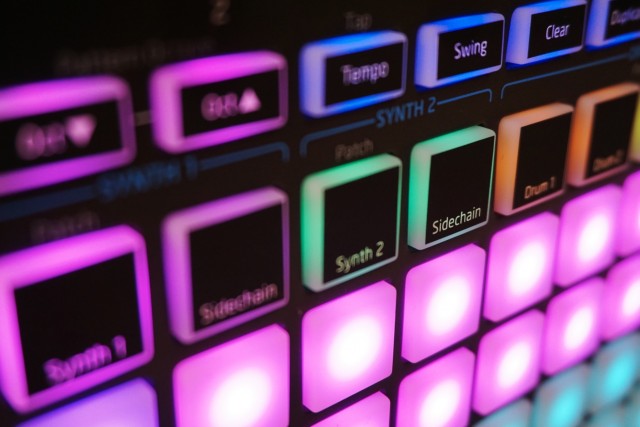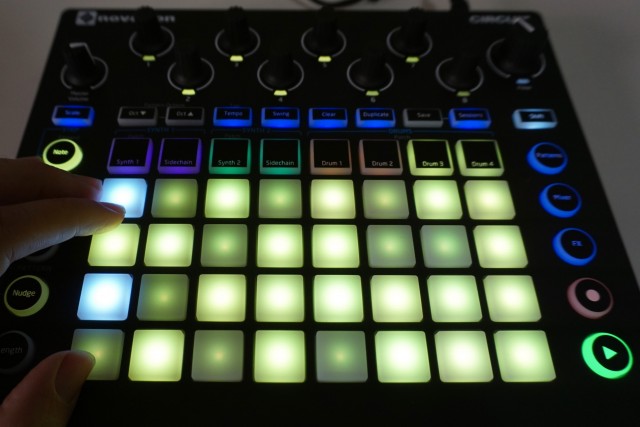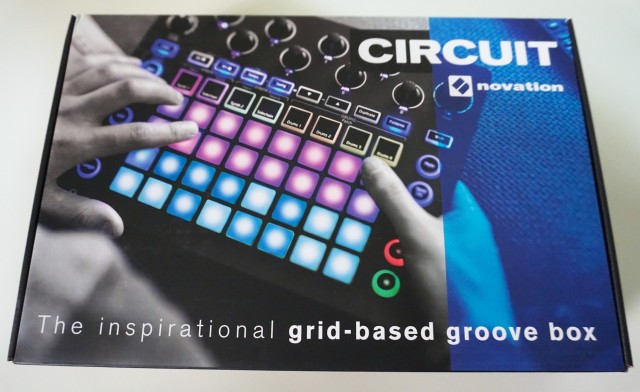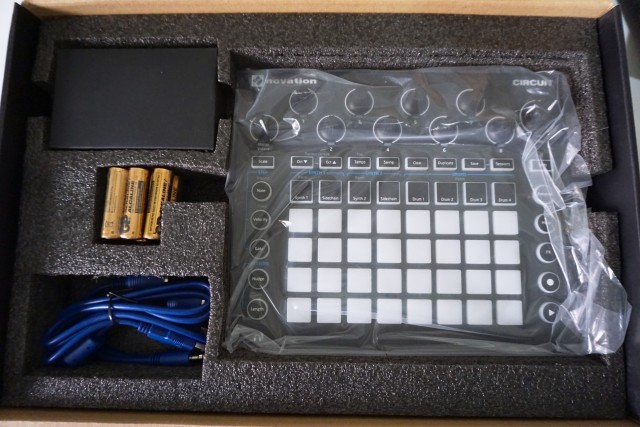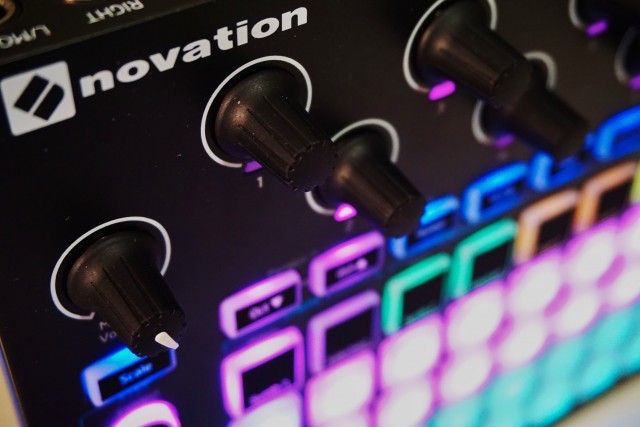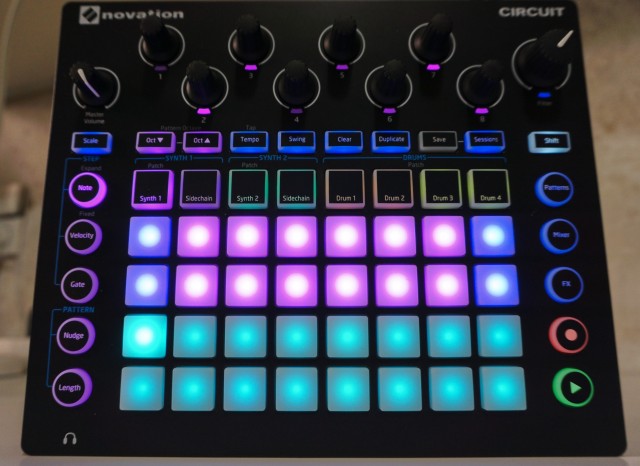Novation has been doing things with grids and knobs for some time, but those have come in the form of gadgets you plug into a computer and use with software like Ableton Live. Circuit is different: it’s an all-in-one groove workstation with sequencer, drum machine, synth, and arrangement in control, and it doesn’t even need to be plugged into power.
We’ve got one of the first Novation Circuit units here, so in advance of our full review, here’s a quick hands-on.
First, Novation’s video shows off the idea:
I first saw Circuit on a visit to Novation’s London office in August – the place where they’re cooking up a lot of their ideas for attracting more people to music. (iOS apps were getting sketched there, too.)
And there, Circuit was immediately all about getting you going with music ideas quickly. (I suspect anyone working for a music technology company, finding their own leisure time severely restricted, appreciates personally the import of getting things started – and of course, that was the topic of the teaser campaign for this hardware.)
So, it starts with an 8×4 grid interface and encoders. Those are velocity-sensitive pads, and the feel of them and the entire build makes this clearly the sibling to the Launchpad Pro controller. The difference here is, you can untether from the computer and use this box on its own. (You can get an idea of what standalone hardware Novation likes in the teaser video, which features a Dave Smith synth, a 303, and an Elektron.)
From there, what do you get?
It’s a modeled synth. There’s a two-part analog-modeled synthesizer in there, which Novation describes as “Nova-heritage.” It certainly has that edgy, modern, somehow English Novation sound.
It’s a drum machine. You get four parts here – simple, but tweakable.
You can play chords. There’s 6-voice polyphony onboard, so you aren’t limited to mono synth lines. And there’s actually a very clever chord mode, which I’ll talk about more when we do the full review.
It’s tweakable – albeit blind. At first blush, this may seem like a preset machine and a bit of a toy. But those eight encoders are paired with a whole lot of parameters for changing the sound. You can switch oscillator types and wavetables, not just twist the filter (though that’s there, too, of course). And all of those encoder adjustments can be recorded and played back in real-time, if you choose.
It’s a step sequencer and pattern recorder. You can play in live, or adjust one step at a time, or a combination (navigating between those modes is atypically easy, in fact). You get up to 128 steps, so you aren’t limited to the 1 bar-patterns you hear in the first demos. Also, if you’re not a fantastic musician on the pads, things do auto-quantize and can be restricted by key – handy for low-pressure live performance. You also get 32 sequence slots for playing live, making this a bit like the Poor Boy’s Octatrack.
It does effects, mixing. Delay, reverb for effects, each fully tweakable, and live mixing plus side-chain capability.
It works with your other gear. USB for the computer, MIDI for external devices. True to form, there’s still a copy of Ableton Live Lite in the box – a bit odd as the main draw here is getting away from your computer. On the other hand, Live (or something like it) is likely to be how you finish whatever you start on the Circuit.
The MIDI support for me keeps this from being overly limited or turning into a toy. You can receive and send MIDI notes and controls, and automatically sync to received MIDI clock (plus forwarding it to the Out jack). More details on that in our review.
It’s ultra-portable and works standalone. You can run on 12V DC power via an adapter, or 6x AA batteries. (I do sort of wish manufacturers would start using rechargeable batteries, though you could invest in rechargeable AA’s if you aren’t already buying AA in bulk for your music gizmos.) But with a decently loud (if tinny) built-in speaker, and a headphone jack, you can go to the park with this one. (Or, as our UK-based friends say, “to the bus” – yes, London will offer long Night Bus trips to start and finish songs.)
And incredibly, the whole package is US$329.99 (£249.99 UK or 349€ including VAT in Europe).
So, how does it feel?
I was actually impressed: this doesn’t feel like a do-everything $300 box. The pads are nicely velocity sensitive and everything feels solid. There’s a blue anti-slip, grippy surface to the bottom. It’s an incredible dirt magnet, but it holds everything in place.
It’s terrifically portable – it’s tough to say just how easy this is to toss in a bag.
Also, it’s clear that Novation has learned a lot from the Launchpad about workflow. You get all of that ready access, minus the computer. You can quickly add patterns, clear, duplicate, nudge, and change pattern length, plus easily get at effects and synth/drum sound parameters.
The oddest part about using the Circuit is perhaps that while all of the usability controls are well-labeled, you often don’t really know what twisting an encoder will do. Only the brightness of the LED underneath tells you the level, and you just have to learn what the assignments are. On the other hand, Circuit really feels like it’s about intuition, experimentation, and happy accidents, so the absence of a display doesn’t really kill the fun.
Let us know if you have questions about this, and what you think, in advance of our full review. Here are some unboxing pics in the meantime. (And yes, it does include the MIDI minijack connections that are fast becoming an accidental standard, plus breakouts and power and USB all in the box for you.)
By the way, this is a 13″ MacBook Pro – it really is small, the Circuit.

